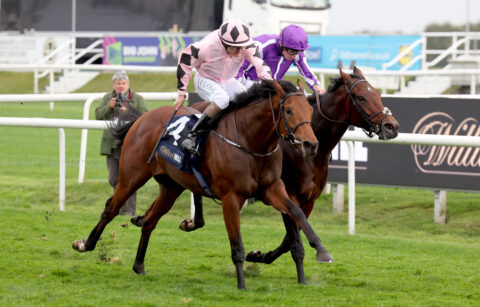Racing Report: First three quarters of 2024

By Richard Wayman, BHA Director of Racing
We are fast approaching the halfway point of the two-year trial of fixture list initiatives that were introduced with the primary aim of boosting the appeal of our sport to racing fans, customers and investors.
It won’t be long before our discussions commence in earnest on what the fixture list of 2026 will look like. Those plans will be led as much as possible by what the data tells us about the effectiveness of the measures in place during 2024 and 2025.
To support our data-led approach, in November 2023 we published twelve targets covering a wide range of areas and this blog provides our latest performance update. The customer data relating to bettors and racegoers is available up to the end of the third quarter, whilst our sporting data, including field sizes, prize money and horses in training, runs to the end of October. Our latest monthly racing data report, which includes detailed sporting data, is now available.
Betting Related Targets
Before reviewing the specific targets, we should reiterate that the betting environment remains challenging with total turnover on British racing in the first three quarters of 2024 down by 9.0% compared with last year, and 18.4% with two years ago. It should be mentioned that there have been fewer races staged this year, so the decline in the average turnover per race is 6.0% compared with last year, and 13.0% with two years ago.
Our colleagues in the betting industry remain positive about the fixture list initiatives that have been introduced this year but the effect of these has been insufficient to compensate for other downward influences, most notably the continuing impact of affordability checks.
Target 1
Total betting turnover on the 33 Saturdays with only three fixtures in the protected window to outperform the other 19 Saturdays by 6 to 7%.
Comparing Saturdays and the impact of the protected window is not straightforward given that there are often differences in the number of meetings staged from Saturday to Saturday. That means that unless we scratch the beneath the surface of the data, we won’t always be comparing apples with apples when trying to analyse the impact of the changes we’ve made.
The betting companies continue to support the concept of a protected window and spreading races more evenly across the day on Saturday, and there is data available to back that up.
Firstly, we have compared betting activity on those Saturdays when there were just three fixtures staged during the protected window from 2pm to 4pm, compared with all other Saturdays. We have excluded the Saturday on which the Grand National takes place as that race alone heavily skews the data. It is interesting to see that the average turnover per race on those Saturdays with three fixtures between 2pm and 4pm has been 10% higher compared with other Saturdays.
Secondly, during the summer racing period, we’ve had six Saturdays when the fixture composition was three fixtures in the afternoon, another starting around 4pm and two in the evening. There have been six other Saturdays during this period when there were four fixtures in the afternoon and two in the evening. The average turnover per fixture at the former when the protected window was in place, was 13% per higher than on those Saturdays with four fixtures programmed during the afternoon.
it is important to acknowledge that, under the current policy, we restrict the number of fixtures to three on those Saturday afternoons when there is a Group 1 or Grade 1 race. It is therefore likely that the protected window Saturdays will also benefit from including at least one strong fixture. That said, the data above clearly illustrates that the better spreading out of races across the day is having a positive impact on betting activity on Saturdays.
Target 2
Total betting turnover on Sunday evening fixtures to outperform midweek (Tuesday to Thursday) floodlit fixtures by 15 to 20%.
This target related to the trial of six fixtures staged in the first quarter of the year. The target wasn’t achieved with total digital turnover averaging only 3.6% higher than midweek floodlit fixtures. As a result, and having also considered feedback from those involved in servicing the meetings, the trial has not been continued at this time.
Target 3
Slowing the decline in betting across the entire fixture list compared with 2023, with Premier Racedays showing 1-2% better relative performance than the remainder of the fixture list.
In terms of comparing Premier Racedays with the remainder of the fixture list, again the data indicates this isn’t a straightforward comparison with some significant variation in the numbers depending on the type of meeting involved. So that we have a benchmark for looking at the different types of Premier Racedays, the average betting turnover per fixture at Core meetings up to the end of the third quarter was down by 5.3%.
Looking at different types of Premier Racedays, the greatest decline has occurred at major Festivals, where the average turnover per fixture has fallen by 12.4%. There are a number of factors behind that including some that were specific to particular Festivals. For example, competitiveness issues and the loss of one race at Cheltenham, the Grand National moving to an earlier race time, and Royal Ascot clashing with the Euros. In addition, there have been fewer concessions offered at these major meetings which the bookmakers have said is largely in response to rising costs.
The betting performance at most other Premier Racedays has been relatively better. The average turnover per fixture at Premier Racedays on Saturdays outside of the major Festivals has declined by 3.9%, whilst at Premier Racedays on other days of the week when the fixture involved previously offered prize money of at least £100,000, has decreased by 3.6%. The small number of remaining Premier Racedays have seen a 5.6% reduction in their average turnover per fixture.
In summary, therefore, outside the major festivals, the extra investment in the Premier Racedays has generally supported an improvement in relative terms in betting performance compared with the rest of the fixture list, albeit activity levels are clearly still under significant pressure.

Attendance Related Targets
The RCA has already reported on attendances to the end of the third quarter, providing some context behind the numbers. In summary, the total number of racegoers this year has fallen by 3.3% from 2023, from 4,053,768 to 3,918,422. However, there have been fewer fixtures staged, meaning that the average attendance has increased by 0.7%, from 3,616 in 2023 to 3,642 in 2024.
Target 4
To halt the decline in total attendances at Premier Racedays in 2024, and then to increase by 5-10% in 2025 versus 2023.
At Premier Racedays, total attendances in the first three quarters have fallen by 48,400 or 2.9%.
Target 5
With 41 Saturdays moving from their traditional start times and four fewer fixtures, that Saturday attendances will have recovered to within 25,000 of their current levels by 2025.
Total attendances on Saturdays have fallen by 70,000 or 4.6%. However, there have been fewer fixtures staged and the average attendance on Saturdays has fallen by 0.5%, from 6,675 to 6,640.
Viewer Related Targets
Target 6
Recognising the impact on those streaming, watching the racing channels or for customers in betting shop, the target is to reduce the number of clashing races (defined as a British or Irish race running into a British race) on Saturdays afternoons (up to 5pm) in 2024 from over 8% to 5%.
Up to the end of October, the number of clashes on Saturday afternoon has fallen from 7.9% to 5.7% of all races staged.
Ownership Related Targets
Target 7
To increase the number of horses that race in Britain by 2.5% by 2025 compared with 2023.
This target is in relation to 2025 but the total number of horses that, up until the end of October, have appeared at least once on a racecourse has declined by 67, or 0.4%.
Splitting this between codes (and noting that some horses appear under both codes), the number of horses appearing in at least one Flat race has increased by 1.2%, whilst the number of horses running in at least one Jumps race has fallen by 3.2%.
Target 8
To increase the number of horses rated 85+ on Flat and 130+ over Jumps. On the Flat, to increase by 5% in 2024 and a further 5% in 2025. Over Jumps, to increase by 2.5% in 2024 and a further 2.5% in 2025.
As with the previous target, there have been contrasting performances between codes. By the end of October, 1,985 individual Flat horses have achieved a BHA performance figure of at least 85. This is up from 1,901 in 2023, thereby representing an increase of 4.4%, just short of our 5% target.
The situation over Jumps is more concerning with the number of horses running to a BHA performance figure of at least 130, declining from 667 to 584. That represents a drop of 14.2%. While we would hope to see a partial recovery on better ground between now and the end of year (albeit the dry period at the time of writing isn’t helping), the reduction in the number of quality Jump horses in training is at the top of the issues that we are looking for ways to address, both in the short and longer term.
Target 9
Total prize money at Premier Fixtures to increase by £6-7m in 2024 and for total prize money at the remainder of the fixture list to return to close to their current levels by 2025.
To the end of October, total prize money has increased by £3.6m from £162.6m in 2023 to £166.2m in 2024. The target for this year as had been for prize money at Premier Racedays to increase by £6-7m and we are on track to achieve than that with an extra £6.6m being offered so far this year, increasing from £79.9m to £86.5m.
The decline at Core fixtures is £3m, from £82.7m to £79.7m. It should be pointed out that there have been nearly 100 fewer races staged this year which will have played some part in this decline. Looking to the future, the Levy Board has recently announced that it will contribute an additional £1m to Core fixtures in 2025. This will be allocated through the Levy Board’s ratecard mechanism in a way that also rewards additional prize money contributions from racecourses.

Competitiveness-related targets
Target 10
To grow average field sizes at Premier and Core fixtures in 2024, both Flat and Jump, compared with 2023.
Target 11
To grow the percentage of races with 8+ runners at Premier and Core fixtures in 2024, both Flat and Jump, compared with 2023.
Target 12
To grow the percentage of races with an odds-against favourite at Premier and Core fixtures in 2024, both Flat and Jump, compared with 2023.
Targets 10 to 12 can be considered together as there is obviously a lot of overlap across these measures. On the Flat, for both Premier and Core meetings, all three measures have improved in 2024 and are at least in line with the best they have been over the past four years. The same positive news can be reported for Core Jump meetings, but Premier Jump meetings are generally below where they were in 2023, although better than in 2022.
We’ve explained in previous blogs that the Premier Jump racedays staged so far this year were largely held in the first four months of the year when the ground conditions were exceptionally soft. However, these meetings have also suffered as a result of the decline in the number of higher rated Jump horses around at the moment, which, as already mentioned, is something that we are working to turn around.
Conclusion
When setting the measures and targets for the fixture list initiatives introduced at the beginning of this year, it was inevitable that other factors outside of the fixture list would also influence our areas of focus.
Other sports and leisure industries are facing a battle to retain their customer numbers, and Racing is clearly no different. The noisy and difficult environment can make it difficult to be categoric about how different initiatives are performing.
Whilst it is a mixed picture and clearly some significant areas of concern exist, there are also grounds for optimism when considering the data from the first nine or ten months of our trial. We’re learning lessons as we go and, as we turn our thoughts to 2026 and beyond, those will be invaluable in determining how the fixture list continues to evolve to grow the popularity of our sport for many years to come.
